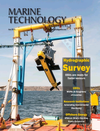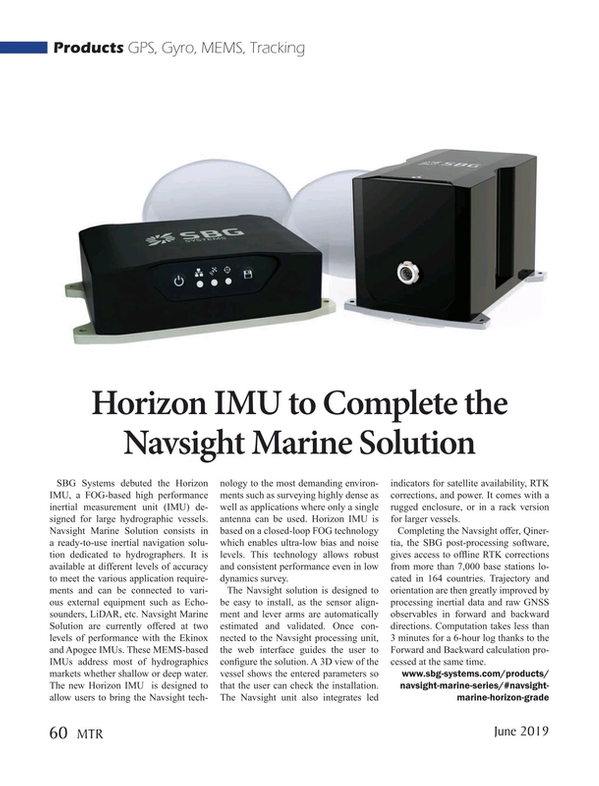
MTR100: Sonardyne International Ltd.
Sonardyne International Ltd.
Hampshire, UK
John Ramsden (Managing Director)
Staff: 290 worldwide
www.sonardyne.com
From the day it was founded close to 50 years ago, Sonardyne’s focus has been customer-driven innovation in our oceans for energy, science and security. Today, it operates on a global scale, providing underwater acoustic, inertial, sonar and optical technologies that are enabling users to position, monitor, measure, detect, image, log, analyze and communicate data, when and where they want in the ocean space.
The company is at the forefront of the drive towards safe, efficient and cost effective marine operations including: the latest in over-the-horizon, unmanned and remote autonomous navigation and data harvesting systems; centimeter-level seabed monitoring for hydrocarbon and geoscience applications; intruder detection systems able to detect and track next generation asymmetric threats in the defense space; and supporting emergent subsea resident robotics systems with hybrid navigation capabilities and super-fast, free space optical communications for live control.
This UK, privately-owned enterprise also has an eye on the future, and 2018 and 2019 has seen it make a number of acquisitions as part of a long-term diversification strategy. This includes environmental monitoring specialists Chelsea Technologies, and Danish maritime survey software and construction firm EIVA. Both organizations are to remain independently run and with their own brands.
Sonardyne’s recent focus includes collaborations with manufacturers of marine autonomous systems (MAS). This spring, its acoustic communications technology has been used onboard an unmanned surface vessel (USV) operating in the North Sea to harvest data from seabed sensor nodes in what is believed to be the first over-the-horizon operation by a UK-based oil major.
Around the same time, the company’s BlueComm optical modems were used to support the world’s first television broadcast from an untethered manned submersible, as part of the Nekton First Descent mission in the Seychelles.
Meanwhile, the company’s leading subsea hybrid navigation instrument, SPRINT-Nav, is helping to push the boundaries of long-range autonomous subsea navigation in partnership with the National Oceanographic Center (NOC). It’s already the instrument of choice for subsea resident vehicles and is supporting the most demanding autonomous underwater vehicle (AUV) applications, from the NOC’s ALR 2KUI to Cellula Robotics’ Solus LR.
Sonardyne’s recently launched Fusion 2 all-in-one Long BaseLine (LBL) and inertial navigation system (INS) technology is also bringing new capabilities and far easier ways of working to subsea survey and construction staff. Its remote access capability also unites with the company’s increasing involvement in MAS.
The Tech
Sonardyne’s heritage is in acoustic underwater technologies. Today, its breadth of expertise embraces high-grade inertial, free space optics (FSO), optical communications and high resolution sonar imaging.
Integrating all the technologies helps the company achieve its goal of making equipment not only more capable, but also simpler to use and, ultimately, to help make survey operations, ocean observation projects more efficient.
Examples include Fusion 2, which supports both LBL and INS operations and reduces hardware requirements. SPRINT-Nav combines inertial, Doppler and depth instrumentation and capability into one compact, low power unit, increases navigational precision and frees up valuable payload for additional mission sensors.
The company’s sixth generation hardware remains a highly regarded choice for positioning, tracking and autonomous monitoring applications. New ‘plus’ hardware, supported by Wideband 3 digital signal architecture, further strengthens the investment case.
Increasingly, Sonardyne is helping ocean space users to monitor and protect their assets. With Sentinel, underwater intruder detection is provided, while Sentry is helping operators to detect oil or gas seeps from subsea assets and reservoirs. Sentry can also spot leaks from emergent CO2 storage sites. Meanwhile, Sonardyne’s Solstice multi-aperture sonar also offers high definition imaging mission from low-logistic AUV platforms.
Read MTR100: Sonardyne International Ltd. in Pdf, Flash or Html5 edition of June 2019 Marine Technology
Other stories from June 2019 issue
Content
- MTR100: #1 Wendy Schmidt, Schmidt Ocean Institute page: 6
- MTR100: #2 Admiral Karl Schultz, Commandant, USCG page: 10
- MTR100: #3 Sven Lindblad, Lindblad Expeditions page: 14
- MTR100: #4 Martin McDonald , SVP, Oceaneering page: 18
- MTR100: #5 Dr. Mark Abbott, WHOI page: 20
- MTR100: Kongsberg Maritime page: 21
- MTR100: Greensea Systems, Inc. page: 30
- MTR100: EvoLogics GmbH page: 33
- MTR100: Five "Ones to Watch" page: 34
- MTR100: InterMoor page: 42
- MTR100: General Dynamics Mission Systems page: 43
- MTR100: Teledyne Marine page: 46
- MTR100: Sonardyne International Ltd. page: 60
- MTR100: National Oceanography Centre (UK) page: 64


